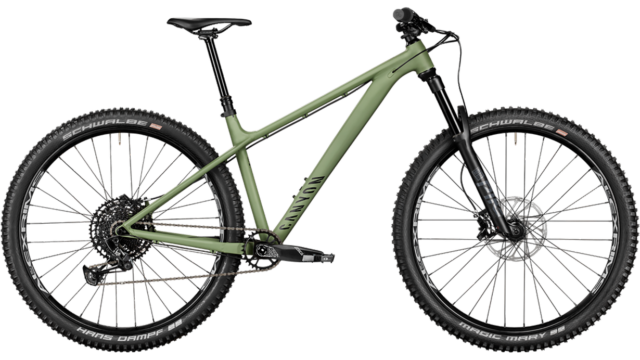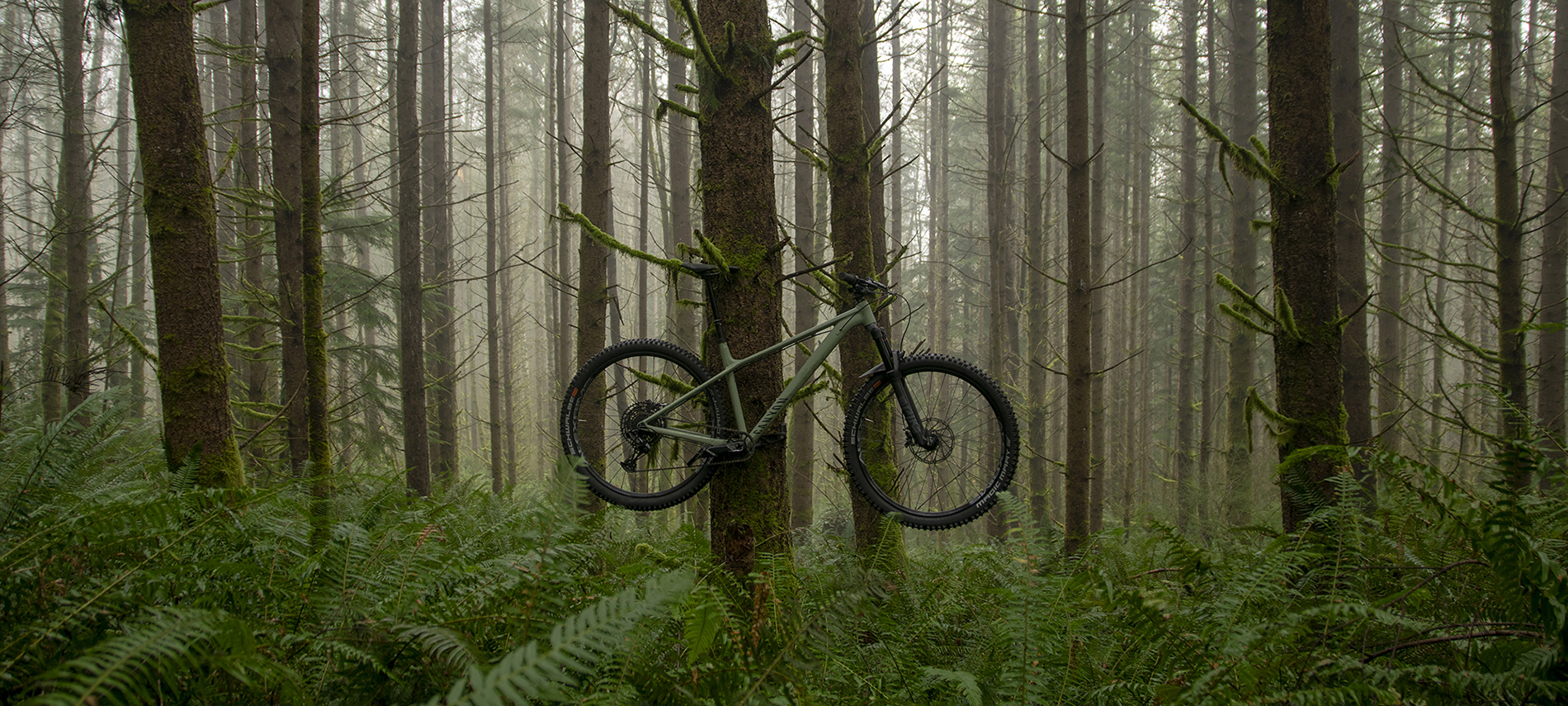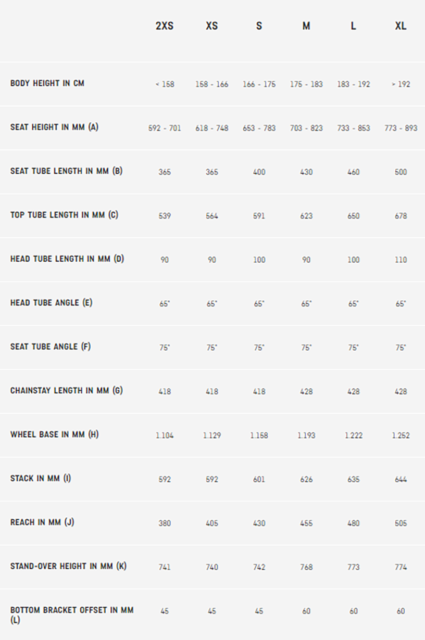2021 Canyon Stoic
Test Location: Washington
Duration of Test: 2 months
Size Tested: Large
Geometry: See Below
Frame Material: Aluminum
Build Overview (Stoic 4, as tested):
- Drivetrain: SRAM NX Eagle (except for a SRAM SX Cassette)
- Brakes: SRAM Guide T
- Fork: RockShox Pike Select RC
- Wheels: Alex DP30 Rims / KT M5ER Hubs
Wheel Size:
- Size XXS–S: 27.5”
- Size M–XL: 29”
Travel:
- Size XXS–S: 150 mm front
- Size M–XL: 140 mm front
Blister’s Measured Weight (as tested; w/o pedals): 31.6 lbs (14.3 kg)
MSRP*:
- Stoic 3: $1,099
- Stoic 4 (tested): $1,799
Reviewer: 6′, 165 lbs (183 cm, 74.8 kg)
[*Prices listed are for the US-specification bikes. Build spec and pricing varies by region. Please check the Canyon website for details in your area.]

Intro
The Stoic is Canyon’s new affordable Trail hardtail, and I’ve been testing the top-tier Stoic 4. Despite being the top of the range, though, the Stoic 4 retails for just $1,799, and it turns out that it’s a whole lot of bike for the money.
Canyon calls the Stoic “a phenomenal trail bike with no added squishy bits,” and it’s tough to argue with that assessment. The Stoic is definitely a hardtail (it does have a suspension fork, if you want to quibble with the “squishy bits” part), and the geometry and parts spec are clearly oriented towards making the Stoic a versatile Trail bike — a light, twitchy XC rig this is not.
So what sort of folks should be adding this less-expensive hardtail to their wishlist? Let’s dive in:
The Frame
All the Stoic models share the same aluminum frame (albeit with different finishes) and it’s simple, but very well thought out. Despite being more affordable than many bikes on the market these days, most of the standard features you’d expect from a modern mountain bike are here on the Stoic.

The Stoic frame features a through-axle with Boost spacing, internal cable routing for a dropper post and the derailleur cable (the rear brake, thankfully, is externally routed underneath the top tube), and post-mount tabs for a 180 mm brake rotor. Adhesive downtube and chainstay protectors are included, too. The only thing that’s missing is a set of chain guide tabs, but modern derailleur clutches largely obviate that need for many people.
The Stoic’s bottom bracket shell is threaded, and the overall lines of the frame are impressively clean — this is a really good looking bike. The matte green finish on our Stoic 4 is particularly sharp. There are mounts for a single bottle cage inside the front triangle, and the rear derailleur cable simply exits via a huge hole at the bottom of the downtube for easy routing.
Size XXS through S bikes get 27.5” wheels, while the M–XL sizes are 29ers. We’ll talk more about that choice in the Fit and Geometry section, but it makes a lot of sense, particularly for a bike that’s offered in very small sizes for shorter riders. The 27.5” frames have stated clearance for up to a 2.8”-wide tire, with clearance dropping slightly to 2.6” width for the 29” sizes.
The Builds
The Stoic is offered in two build specs in the US, the Stoic 3 and Stoic 4. Europe gets a third build tier, and, confusingly, a reshuffling of the naming for the lower-level builds. Check Canyon’s website for the particulars in your area, but the overview is as follows:
US:
Stoic 3: $1,099
- Drivetrain: Shimano Deore M6000 10 speed
- Brakes: Shimano MT200
- Fork: SR Suntour XCR 34
- Wheels: Alex DP30 Rims / Shimano M4050 Hubs
- No dropper post
Stoic 4: $1,799
- Drivetrain: SRAM NX Eagle (except for a SRAM SX Cassette)
- Brakes: SRAM Guide T
- Fork: RockShox Pike Select RC
- Wheels: Alex DP30 Rims / KT M5ER Hubs
- Canyon Iridium Dropper Post
Europe:
For European markets, the US-spec Stoic 3 is rebranded as the Stoic 2, and retails for €799. The European Stoic 3’s build overview is as follows:
Stoic 3: €1,199
- Drivetrain: SRAM SX Eagle
- Brakes: SRAM Level T
- Fork: RockShox Recon Silver RL
- Wheels: Alex DP30 Rims / KT M5ER Hubs
- Canyon Iridium Dropper Post
And finally, the European Stoic 4 is the same build as the US-spec version, and retails for €1,699.
The Stoic 4 that we’ve been testing comes with a SRAM NX drivetrain (except for a SRAM SX cassette), a RockShox Pike Select fork, Canyon’s house-brand Iridium dropper post (125 mm drop on the XXS frame; 150 mm on XS and S sizes; 170 mm on M–XL bikes), and Alex DP30 rims laced to Shimano MT400 hubs. Sram Guide T brakes handle stopping duties, and come with 180 mm rotors at both ends on XXS through S sizes; the bigger frames bump up to a 200 mm front rotor.

There’s nothing flashy here but it’s a very solid, no-nonsense spec, and there’s nothing that jumps as not being up to the task of serious mountain biking. All versions even come with high-end tires — a Schwalbe Magic Mary in a 2.4” width and Addix Soft rubber with their new Super Trail casing up front, and a 2.35” Hans Dampf with the same casing and rubber in back. It’s common for brands to spec basic, hard-rubber tires on bikes in this price range, so it’s great to see Canyon not cutting any corners. The tires also come set up tubeless, with Muc-Off sealant.
To round things off, the Stoic also comes with a basic torque wrench and bit set for assembly, a shock pump, a water bottle and cage, and a front fender pre-installed. Those things are particularly nice since Canyon is a direct-to-consumer brand and they make setting up the Stoic out of the box an especially straightforward process.
Fit and Geometry
The geometry of the Stoic is very much aimed at making for a versatile bike that’s not going to be immediately under-gunned when a trail gets rowdy, but it’s not going totally wild in making a hyper-aggressive, long / low / slack monster, either.
The headtube angle sits at a moderate 65°, reach ranges from a short 380 mm on the XXS frame, through a roomy 505 mm on the XL (in neat 25 mm increments between sizes), and the chainstays start at a short 418 mm on the XXS–S frames (which, to reiterate, get 27.5” wheels) while the M–XL sizes jump to 428 mm chainstays and 29” wheels.
All of that adds up to wheelbases ranging from 1104 mm to 1252 mm (1193 mm on a size Medium), and all sizes get a 75° seat tube angle. Sizes with 27.5” wheels get 45 mm of bottom bracket drop, while the 29er versions get 60 mm, to compensate for the bigger wheels. You can see the full geometry chart here:
Canyon says that “From the start, our goal was to strike a balance between new school progressive trail bike geometry while keeping the Stoic agile and playful enough for the pump track and the jumps.” Based on where they’ve ended up, I think that makes a ton of sense. The Stoic isn’t as hyper-aggressive as some newschool hardtails such as the Chromag Doctahawk, Marin El Roy, or Kona Honzo ESD, but it’s by no means an XC bike, either. The numbers Canyon has chosen add up to a very versatile bike that’s quite capable, but also isn’t so out there that it needs a wild amount of speed and aggression to come alive.
We’re also really into the fact that Canyon is offering the Stoic in sizes down to an XXS, which they recommend for riders as short as 4’10” (149 cm). Particularly given that they’re offering the Stoic in such small sizes, it also makes a ton of sense to split the size range by wheel size — 29” wheels undeniably do some things well, but they’re also not the be-all, end-all of mountain bike wheel sizes, and come with their own set of drawbacks. In particular, the combination of a big 29” front wheel and a fork tall enough to clear it raises the front end / stack height considerably, and can pose real problems when it comes to sorting out bar height. Similarly, the larger rear wheel can limit how much a rider, particularly one with shorter legs, can move around on the bike without buzzing the rear tire, so going to the smaller 27.5” wheels for smaller sizes is a great call.
The size-specific component selection doesn’t stop at wheel size, either. Canyon also varies the handlebar width and crank length by size. The XXS and XS Stoic gets a 740mm-wide bar and 165 mm cranks, the S bumps up to a 760 mm bar, and then M–XL sizes jump up to a 780 mm bar and 170 mm crank arms. This is hardly a novel idea, but it shows that Canyon has put some real care into tweaking the Stoic for a range of rider sizes. And while there’s no women’s-specific version on offer, the wide range of sizes for the Stoic do mean that it’s a viable option for a whole lot of riders, including smaller women and many teenagers.
On The Trail
The Stoic delivers on its promise of being a very solid, very versatile hardtail for not a ton of money. Its handling is intuitive and strikes a good balance between stability and agility. I’ve been riding the Stoic on many of the same trails where I’d often choose to ride a ~160mm-travel full-suspension Enduro sled, and while the Stoic certainly isn’t as composed or forgiving on steep, rough terrain, it’s more than capable of tackling it, should the occasion arise.

Where the Stoic feels most at home, though, is more varied, rolling terrain. Some bikes feel like they were designed with a very singular purpose in mind, and excel within a fairly narrow use case. The Stoic is the opposite. It’s not a bike that is superlative at any one thing in particular, but instead is up for a little bit of anything. Its handling is sharp enough to feel lively and fun on mellow, rolling terrain, and to navigate tight technical jank without feeling like you’re piloting a supertanker. It’s stable enough to handle some steep, rough trails with a capable rider and a little deference to the fact that it is, after all, a hardtail. And while I’ve only briefly taken the Stoic to a pump track and set of dirt jumps, it’s a lot of fun there, too, particularly for a bike that’s not dedicated to those disciplines — and much more so than just about any full-suspension bike.
At 31.6 lb / 14.3 kg (size Large, without pedals), the Stoic is a little on the portly side for a hardtail, but it’s no boat anchor, either. The climbing position is good (and if the 75° seat tube angle sounds a bit slack by modern standards, remember that there’s no rear suspension to sag through; the seat tube only gets steeper once the bike is weighted). Of course, that lack of rear suspension does mean that climbing traction is a bit more limited than it would be on a full-suspension bike, and rougher sections of climbing aren’t as comfortable as they might be with a bit of rear suspension to soften the blows. The Stoic isn’t out of the ordinary for a hardtail in this regard — it just is a hardtail.
My only major gripe with the Stoic 4 is the Matchmaker clamp used to mount the shifter and rear brake lever on a shared perch. I don’t mind SRAM’s newer Matchmaker X clamp, which is featured on their higher-end brakes, but the original version used on the Guide T brakes that come on the Stoic 4 doesn’t allow for nearly enough adjustment of the angle of the shifter relative to the brake lever for my preferences. With the brake levers positioned to my liking (which is perhaps flatter than average, but not as extreme as Yoann Barelli spec), I’m not able to rotate the shifter back to a comfortable position. Reaching the downshift paddle isn’t too bad, but in order to upshift, I need to substantially move my grip on the handlebar to rotate my thumb forward and reach the shifter, despite having relatively large hands. It’s annoying and unnecessary, and I’d much rather see the brake lever and shifter mounted on separate clamps for maximum flexibility. The good news is that separate clamps are available to swap in if you find the layout as annoying as I do, but it’s a hassle to have to resort to that, and all for the minor aesthetic improvement of having a single clamp on that side of the bar?

Canyon’s built-in chainstay protector also isn’t really up to the task of quieting chain slap. It’s just a bit too thin and lacks sufficient cushioning to get the job done, but it would be an easy fix with an aftermarket protector, or a bit of rubber mastic tape.
Overall, though, the Stoic has been impressive. The throughline with this bike has to be just how good a job Canyon has done with the design and spec to come up with a bike that can do a little bit of everything, and doesn’t have any glaring shortcomings, for not a whole lot of money.
The Stoic 4’s RockShox Pike Select shares its chassis and air spring with the swanky Pike Ultimate, and while you don’t get the high-end Charger 2.1 damper (or shiny silver finish), it still features adjustable low-speed compression and rebound in an entirely competent damper. The SRAM NX drivetrain weighs a bit more and doesn’t shift quite as crisply as their more expensive offerings, but it works just fine. The Stoic 4 even comes with four-piston brakes and big rotors, and while the SRAM Guide T brakes don’t have all the bells and whistles or quite as much power as the more expensive variants, they’re solid as well. I did swap the stock resin pads for a set of sintered metallics after a few rides, which bumped the power up a bit (especially in the wet), but apart from that one tweak I haven’t changed the spec on the Stoic at all.
Who’s It For?
Canyon has put together a very impressive bang-for-buck package here, but who exactly does it make the most sense for?
For starters, the Stoic would be a great call for relatively inexperienced mountain bikers who are looking to buy their first mountain bike without blowing a huge amount of money. While we don’t necessarily subscribe to the “back in my day” line of thinking that says that everybody should learn to mountain bike on a hardtail, doing so undeniably is a good way to build fundamental skills, and is simply a valid way to save money on a bike while still ending up with something solid and functional. And although there’s no women’s-specific version on offer, the fact that the Stoic is offered in such a big range of sizes means that it’s also a valid option for a lot of teenagers and shorter adults, who would often be left out of normal men’s / unisex bike sizing.
Of course, the tradeoff is that a hardtail won’t be as comfortable or forgiving on rough terrain as a full-suspension bike, and if a beginner or intermediate rider just wants that added degree of comfort and compliance, by all means — get a full suspension bike. Conversely, though, a hardtail will be a whole lot more efficient and fun to ride on pavement or mellow gravel trails than a full-suspension bike, and if your intended use is a mix of that, plus some dabbling in riding singletrack, something like the Stoic makes a whole lot of sense.

At the same time, the Stoic — particularly the Stoic 4 — is absolutely “enough” bike for the seasoned mountain biker looking to add a hardtail to their quiver to complement a full-suspension bike (or multiple bikes, as the case may be). The Stoic’s geometry is well sorted for a versatile Trail bike, and while the hardcore mountain bike aficionado might end up upgrading some parts here and there along the way, the Stoic 4 is very much up to letting that rider test the waters of hardtail ownership.
Bottom Line
Canyon has put together a well thought out, versatile hardtail in the Stoic, and managed to offer it at a very competitive price. Riders looking for a simple, no-nonsense bike that can handle a little bit of everything for not a ton of money should take note, as long as they’re game to forgo rear suspension. While that won’t be for everyone, there are a whole lot of people out there who would be well served by the Stoic, and Canyon should be commended for putting together the spec that they have, and offering it in an especially wide range of sizes.


That Stoic 3 might make me cancel my pending Kona hardtail preorder…
Their size chart indicates that as a 6’tall person, you should be on a Medium.. yet you reviewed a large… did the big “feel” the right size, or did you find you would have rathered a smaller size? (Curious as I’m about 6′ and heavier than you.. but when buying/considering a bike knowing that there won’t be a test ride.. curious on sizing thoughts vs their thoughts/advice.)
At 183 cm (6′) I’m right on the tipping point between a medium and a large on the geo chart — they include 183 cm in both ranges. For me personally, the large is 100% the right call, but I’m also used to and prefer relatively long bikes. How big the large feels to you is going to depend a bit on what you’re used to and what your riding style and preferences are like. I’d be inclined to steer most ~6′ tall, experienced riders towards the large, but it will take a little more effort and technique to muscle around than the medium, and if you’re used to / prefer smaller bikes and are worried about the large feeling huge, I don’t think it would be crazy to go smaller.
I’ve had my Stoic 4 for a year now and I absolutely love it. I have several bikes and my main bike was a Trek Fuel and my Stoic has taken over that spot. I do still ride the Fuel, especially on the rougher stuff, but this bike is great…other than In the first 3 months I stripped the ratchet ring in the Alex Rims hub. That may be me though, I’m 6’4 and 225 and go through drivetrains often. This is my third hub failure in the past few years. Swapped that out and no issues since…and the new lighter wheels makes it more fun.
Hi Mike,
What size did you go for? I’m looking to buy a Stoic but sit between the L/XL, I’m also 6’4 with a very large inside leg, my other XL bikes – Giant and specialized seem slightly small with the seatpost near maximum.